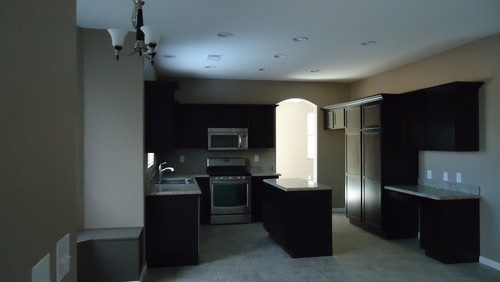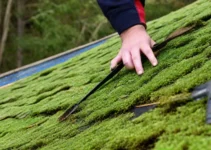What can be worst than a fire? A house fire is devastating. There is damage to your house and its contents from the fire itself. And once the fire is extinguished you have to deal damage caused by smoke and the water and chemicals firefighters use to put a fire out.

Photo by WESTSIDE RESTORATION & Remodeling – Discover kitchen design inspiration
Smoke damage causes black marks and discoloration to your walls and ceiling. Smoke damage to your walls and ceilings also, can be a vexing problem and is extremely unpleasant to clean. In fact, smoke damage is both seen and unseen in the aftermath of a house fire.
1/ The damage that you can see is from soot and charring. Charring is the actual burning of the paint.
What is soot?
When the burned materials or fuel load are not consumed completely, a black residue made up of impure carbon particles, known as soot, is formed. Soot is actually very oily, because when the plastic that makes up household and building materials burns, there are greasy molecules released into the air.
Soot is considered a particulate matter which is a microscopic particle that is deemed dangerous or hazardous to one’s health especially when it gets to the person’s respiratory system.
Once these particulates find their way into the person’s alveoli, they dissolve into the bloodstream and get carried into the different tissues of the body where it awaits the accumulation of significant levels in order to effect a pathologic reaction.
One major health effect of soot, especially its gaseous phase, is the production of polycyclic aromatic hydrocarbons which have been studied to cause mutation of a select group of genes, some of which can cause a variety of child birth defects, and have been tagged as a possible human cancer-causing agent.
2/ The damage that you cannot see, but can smell, is smoke odor. This is also a molecular problem, and must be dealt with at the molecular level. Removing the smoke odors properly will help restore your home without causing any further damages. If you have difficulty restoring your home, contact a professional fire restorer to aid you in the process.
How to Clean Smoke Damage
After the devastation of a fire, there is a sizable secondary task after replacing all destroyed property. This entails cleaning up the tremendous amount of damage caused by the smoke from that fire. And when it comes to smoke damage, you must always remember that the longer you leave your house exposed to smoke the harder it will be to clean everything out.
What You Will Need
- Trisodium Phosphate (TSP) cleaner – is a harsh cleaner and if you do not wear gloves, you run the risk of severe skin irritation.
- Large Sponge (such as the type you’d use to wash a car)
- 2 Buckets
- Warm water
- Heavy duty rubber cleaning gloves
- Goggles; face mask
- Clean rags
The Cleaning Process
1 – Put on the proper safety equipment, including a face mask and gloves
2 – You should begin by air out the entire house. It doesn’t matter if only one area of your house is affected. Ventilate your house well by opening windows and running fans.
3 – Surfaces cleaning after the fires are carried out with the purpose to remove traces of soot and to reduce content of carcinogenic combustion products in superficial layers of the finishing materials. First suck up soot using a vacuum cleaner attachment nozzle (don’t use an upright vacuum as this tends to grind the soot into the carpet).
Soot stains easily, so it should be cleaned up before any further deodorizing or cleaning occurs.
4 – Fill the bucket with 1 gallon of warm water and add 1 generous tablespoon of TSP.
- Wearing goggles and rubber gloves, wet the sponge in the TSP solution.
- Working one section a time, wipe wall/ceiling vigorously with the sponge, then rinse thoroughly with a rag dipped in clean water. Continue until entire area has been washed and rinsed.
- You may have to repeat the wash/rinse several times, depending upon the severity of the soot buildup and charring.
- You will need to prime your walls/ceilings and repaint
- Bubbling and blistering of the paint on your walls and ceiling may occur from excessive heat – but can be repaired.
5 – Clean appliances thoroughly with a disinfectant. Smoke can cause malfunctions in the appliance mechanisms, so clean and test until the appliances run smoothly.
6 – Change the air filter on your air conditioner as a great deal of soot will have built up in the filter after exposure to smoke damage.
*** Removal of soot and smoke damage and smell of burning after the fire is very slow and expensive process. After the surfaces are cleaned with scrapers and brushes it is necessary to apply sealing layer to remove smell in case if soot and smoke remains in surface pores.
Smoke Odor
The problem with smoke odor is that it cannot simply be covered up. No deodorant is powerful enough to permanently overcome the acrid, unique smell of smoke. The fact is that once smoke molecules permeate, they can’t be removed. They must be disabled.
Depending upon how strong the smoke odors are, one or more of these methods may prove helpful.
1 – White vinegar cuts through odors naturally. Try wiping down furniture, washable walls, floors, etc. with white vinegar.
2 – Baking soda is another natural odor-absorber. Try sprinkling liberal amounts of baking soda over furniture, floors, etc. Leave a few bowls of baking soda around the room for several days to help absorb the odors.
3 – Spraying the area down with Febreze may help to reduce the smoke odor.
4 – Activated charcoal is a natural odor absorbent. Placing bowls of activated charcoal (powdered form) around your room may help to absorb the smoke odors.
5 – Professional companies can “kill” the odor molecules with specially designed fogs.
6 – There are products on the market known as Ozone Generators which may help in reducing or even eliminating smoke odor from your house.
Avoid more Serious Damages Patching a Gutter Leak (howtobuildahouseblog.com)


